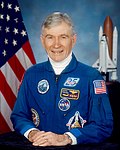Wikipedia talk:Featured article candidates/John Young (astronaut)/archive1
From Moon Bound. The part I think would be the greatest benefit are as follows;
On p. 158, "From 1955 to 1959 Young served with Fighter Squadron 103, then attended the U.S. Navy Test Pilot School as a student in Class 23. After graduation he remained
p. 159 "at the Naval Air Test Center for three years. As a test pilot and program manager, he was attached to test projects to evaluate the F8D and F4B fighter weapons systems for the Navy. He was also Maintenance Officer of All-Weather Fighter Squadron 143 at NAS Miramar, California. Early in 1962 he set time-to-climb records for the 3,000 meter and 25,000 meter events in Project High Jump."
Still on the same page, regarding his post-Apollo career: "Capt. Young's next assignment was to command the inaugural flight ofthe space shuttle. On 12 Aprill981 (precisely 20 years after cosmonaut Yuri Gagarin made the first human space flight) Young and pilot Bob Crippen soared into space on the two- day STS-1 mission. In October 1983 he commanded STS-9 on a ten-day flight with a then-record crew of six, including scientists, to operate the European-built Spacelab module on its maiden flight. Prior to the loss of shuttle Challenger in January 1986, Young had been named to fly a historic seventh space mission in September of that year to deploy the Hubble Space Telescope. But the loss of Challenger and her crew prompted Young, who was chief of the Astronaut Office, to opeuly question NASA's safety standards and procedures. When the flight was later rescheduled, he had been replaced as mission commander and given the job of Special Assistant to the Director of the Johnson Space Center for Engineering, Operations and Safety. John Young retired from NASA on 31 December 2004, aged 74. Throughout his 42 years with the agency he remained an active astronaut, still eligible to command space shuttle missions."
John Young was an American astronaut, naval officer, test pilot, and aeronautical engineer. He became the ninth person to walk on the Moon in 1972. He flew on four different classes of spacecraft: Gemini, the Apollo command and service module, the Apollo lunar module, and the Space Shuttle. After joining the U.S. Navy and serving at sea during the Korean War he became a naval aviator, and graduated from the U.S. Naval Test Pilot School. As a test pilot, he set several world time-to-climb records. In 1965 Young flew on the first crewed Gemini mission, and commanded the 1966 Gemini 10 mission. In 1969, he flew as the command module pilot on Apollo 10. He was the commander of Apollo 16, and walked on the Moon's surface. Young also commanded STS-1 in 1981, the Space Shuttle program's first launch, and STS-9 in 1983, both of which were on Columbia. Young served as Chief of the Astronaut Office from 1974 to 1987, and retired from NASA in 2004. He died in 2018 at the age of 87. (Full article...)
1,004 characters, including spaces
Hi Balon Greyjoy and congratulations. A draft blurb for this article is above. Thoughts, comments and edits from you or from anyone else interested are welcome. Gog the Mild (talk) 22:13, 2 January 2021 (UTC)

